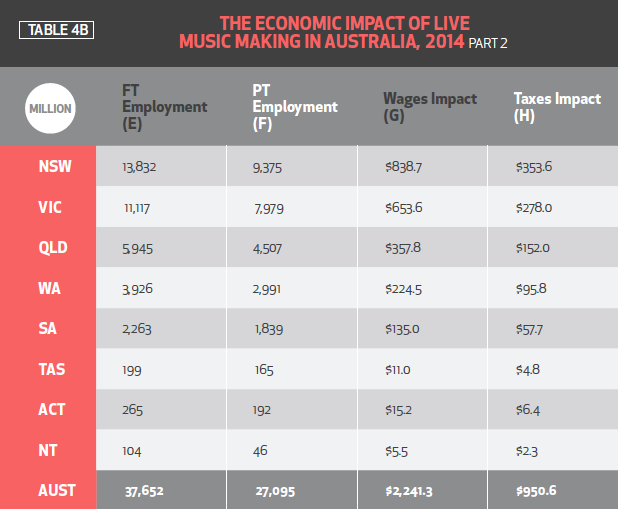Projects
For the purposes of this study, a civic benefit is a contribution made by having live music making in Australia that would otherwise have to be provided (presumably by the state) if the same community-wide standard of living were to be enjoyed. In other words, it typically represents a cost avoided by government.
Input / output modelling
Two instances of civic benefit are easily and immediately identified.As shown in Table 4b, the expenditure associated with live music making is estimated to generate in the order of 64,747 jobs, 37,652 of which are full-time. This is a benefit of 2.2 billion dollars directly returned to households, with an equivalent welfare cost avoided by government.It is also observed that the estimate of taxes generated by live music-related or motivated expenditure is 950.6 million dollars.
Note that the taxation receipts may not be directly proportional to the relevant investment of each tier of government. Nevertheless, as it is unlikely that the live music industry receives an equivalent quantum of re-investment from government; it could be argued that the direct tax returns from live music making are used to finance other policy and social investments, such as hospitals and schools.
Civic benefits acknowledged by not quantified by this study include the significant levels of volunteering that occur within live music making in Australia, as well as the costs potentially avoided by our civil systems of health, criminal and social justice.
Other civic benefits
There are a number of formal systems of care that are paid for by society through taxes and personal expenditure. These include all private and public, recurrent and capital expenditure on health, criminal and social justice. The discussion on Capital describes how these are realised through live music. Our survey of producers also revealed significant levels of volunteering in the live music community; the replacement cost of that labour being another that effectively subsidises the activity and is avoided by the community.
Furthermore, every time that Australia is internationally associated with a live music event or activity, event or individual, it ‘brands’ the country—all be it temporarily—in the wider public consciousness. Such links are known to influence related purchase behaviour (Balabanis & Diamantopoulos, 2011; Kang & Yang, 2010). For regions or the nation as a whole, this means that people make tourism, export or even migration decisions that are founded on the strong and positive associations they have with the live music brand.
Research conducted by Dobos (2011) for Tourism Tasmania, for example, found that Art and Island Culture was a key factor in motivating and attracting tourists. As a significant player in the nation’s cultural economy, it is reasonable to suggest that live music has a prominent role to play in this associative dynamic.
Philosophers from Aristotle to Dworkin (2006) have also argued that a robust democracy depends on the active participation of its citizens. The logic has been that for a government to be truly representative, as many constituents as possible must be connected and contributing to the social discourse. Putnam (2000) proposes that social capital is the mechanism that facilitates this, and research in this field strongly connects Arts participation—of which live music is a notable subset—with a willingness to vote and engage in formal political membership (ISSP, 2001).
At a more fundamental level, live music and its expressions are regularly used as a ‘meeting point’ in water-cooler discourse. The shared recognition of the characters and symbols in live music facilitates conversation and acts as a focal point for social debate, which in turn informs policy. It is further acknowledged that live music can act as a gateway for those marginalised to either contribute toward a political cause, draw strength from, or generate ideas that bring about political change (Caruso, 2005).
Due to the scope of this report, an attempt has not been made to locate and assign an economic value to these additional live music benefits; no doubt many more could also be identified. This is recommended as a direction for future research.
